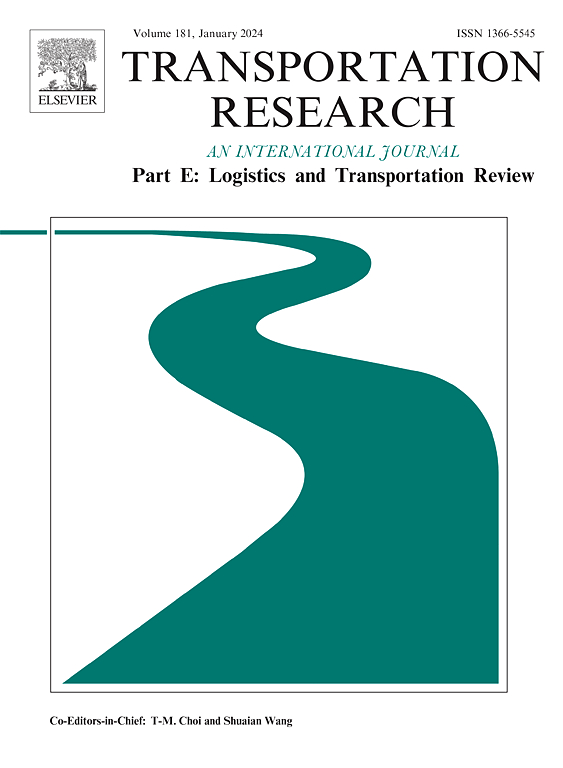不确定性下的脱碳补贴路径导航
IF 8.8
1区 工程技术
Q1 ECONOMICS
Transportation Research Part E-Logistics and Transportation Review
Pub Date : 2025-04-05
DOI:10.1016/j.tre.2025.104101
引用次数: 0
摘要
目前关于碳补贴制度的辩论主要集中在确定适当的预期接受者和澄清其在可持续经营中的作用。本文通过考察碳补贴制度在创新和需求不确定性下对脱碳激励、盈利能力、可持续性和福利的影响,评估了碳补贴制度的有效性。为此,我们为政府实施供给侧或需求侧补贴制度的情况开发了模型,以及没有任何补贴的基准模型。均衡结果分析表明,当环境系数高(低)时,补贴企业(消费者)能够有效激励脱碳创新。一个重要的发现是,供给侧补贴制度可以为政府、企业、消费者和环境带来三赢的结果;然而,需求侧补贴制度可能会破坏可持续性,尽管提高了盈利能力和福利。此外,随着脱碳成功概率的增加,政府倾向于补贴消费者,而需求不确定性的增加或消费者的低碳偏好将促使政府转而补贴企业。我们将模型扩展到双边补贴情景,证明这种制度可能不能保证帕累托改进,因为在某些情况下,它降低了盈利能力和可持续性。值得注意的是,当:(i)政府补贴预算有限,(ii)政府补贴企业的生产成本而不是投资成本,(iii)成功脱碳的概率取决于企业的投资努力,或(iv)绿色产品和传统产品在市场上共存,相互竞争销售时,我们的主要发现仍然是强有力的。本文章由计算机程序翻译,如有差异,请以英文原文为准。
Navigating the subsidy path to decarbonization under uncertainties
The ongoing debate about the carbon subsidy regime focuses primarily on identifying the appropriate intended recipients and clarifying its role in sustainable operations. This paper assesses the effectiveness of the carbon subsidy regime by examining its impact on decarbonization incentives, profitability, sustainability, and welfare amidst uncertainties in innovation and demand. For that purpose, we develop models for cases where the government implements either the supply-side or the demand-side subsidy regime, as well as the benchmark model without any subsidy. Analysis of the equilibrium outcomes shows that subsidizing the firm (consumers) can effectively incentivize decarbonization innovation when the environmental coefficient is high (low). A key finding is that the supply-side subsidy regime could yield a win–win–win–win outcome for the government, the firm, consumers, and the environment; however, the demand-side subsidy regime may undermine sustainability despite enhancing profitability and welfare. Moreover, the government tends to subsidize consumers as the probability of successful decarbonization increases, whereas heightened demand uncertainty or consumers’ low-carbon preferences will prompt the government to subsidize the firm instead. We extend the model to the bilateral subsidy scenario, demonstrating that this regime may not guarantee a Pareto improvement because, in some cases, it reduces both profitability and sustainability. Notably, our main findings remain robust when: (i) The government has a finite subsidy budget, (ii) the government subsidizes the firm’s production cost instead of the investment cost, (iii) the probability of successful decarbonization is dependent on the firm’s investment efforts, or (iv) green and traditional products coexist in the market cannibalizing each other’s sales.
求助全文
通过发布文献求助,成功后即可免费获取论文全文。
去求助
来源期刊
CiteScore
16.20
自引率
16.00%
发文量
285
审稿时长
62 days
期刊介绍:
Transportation Research Part E: Logistics and Transportation Review is a reputable journal that publishes high-quality articles covering a wide range of topics in the field of logistics and transportation research. The journal welcomes submissions on various subjects, including transport economics, transport infrastructure and investment appraisal, evaluation of public policies related to transportation, empirical and analytical studies of logistics management practices and performance, logistics and operations models, and logistics and supply chain management.
Part E aims to provide informative and well-researched articles that contribute to the understanding and advancement of the field. The content of the journal is complementary to other prestigious journals in transportation research, such as Transportation Research Part A: Policy and Practice, Part B: Methodological, Part C: Emerging Technologies, Part D: Transport and Environment, and Part F: Traffic Psychology and Behaviour. Together, these journals form a comprehensive and cohesive reference for current research in transportation science.

 求助内容:
求助内容: 应助结果提醒方式:
应助结果提醒方式:


